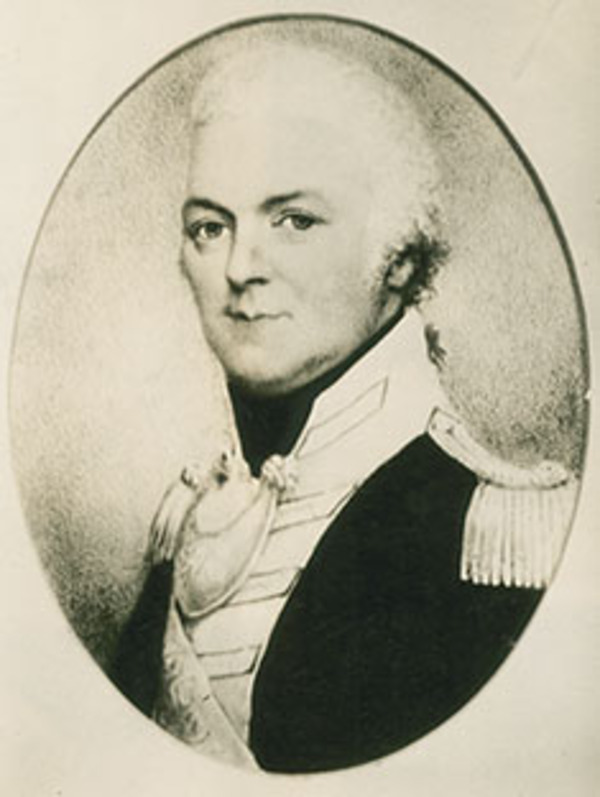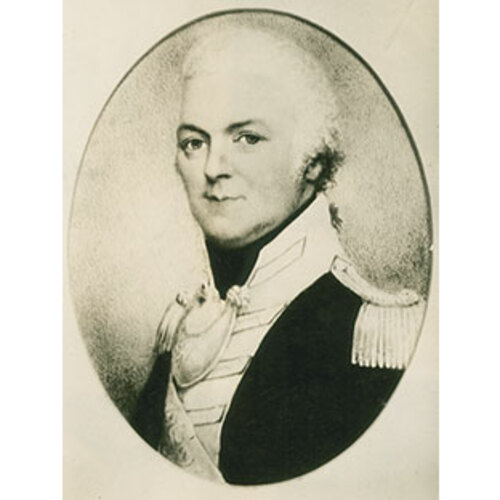As part of the funding agreement between the Dictionary of Canadian Biography and the Canadian Museum of History, we invite readers to take part in a short survey.

Source: Link
WHITE, GIDEON, jp, merchant, office holder, politician, militia officer, and judge; b. March 1753 in Plymouth, Mass., son of Captain Gideon White, yeoman, and Joanna Howland, both descendants of Pilgrim Fathers; cousin of Edward Winslow*; m. 17 April 1787 Deborah Whitworth, daughter of Dr Miles Whitworth of Boston, in Shelburne, N.S., and they had nine children, all of whom lived to adulthood; d. there 30 Sept. 1833.
Ten days after the battle of Bunker Hill in June 1775 Gideon White was relating his eyewitness account of that engagement to Simeon Perkins* in Liverpool, N.S. White, a Plymouth merchant, had just arrived from Boston on a trading voyage to Nova Scotian ports including Port Roseway (Shelburne). Because his movements during the next several months are unknown it is not certain whether he was the Gideon White who joined the evacuation of Boston in March 1776. By the summer, however, White was in Nova Scotia once more, and that September was captured by an American privateer off Barrington and taken to Massachusetts. Imprisoned and then placed under house arrest in Plymouth, in October 1777 he returned to Nova Scotia where he spent the winter of 1777–78 in Liverpool. By September 1779 he was in New York, and as master of the schooner Apollo traded in the Caribbean for a year. White then set up business as a merchant in Charleston, S.C., where he also served as a captain in the local militia prior to returning to New York in July 1782. By now a captain in the Duke of Cumberland’s Regiment, he went to Jamaica to recruit, but with the end of hostilities in sight the recruits were not needed, and he returned to New York in the late fall to await evacuation.
At this time a group of refugees in New York formed an association to organize a settlement at Port Roseway. Since White was one of those familiar with the intended destination he was able to provide helpful advice and information. He became a member of the Port Roseway Associates, as the group was known, but because of ill health could not go with them when they left for Nova Scotia in the spring of 1783. Instead, that summer White returned to Jamaica to help gather his disbanded regiment and remove it to Nova Scotia, where its members were to receive land. He arrived at Halifax in February 1784 and that spring came to Shelburne with some of his regiment. The Duke of Cumberland’s Regiment was granted land in the Chedabucto Bay region but White never saw his 850 acres there.
White’s letter of introduction to John Wentworth*, surveyor general of the king’s woods, reaped results with his appointment by Governor John Parr* as justice of the peace for Halifax County in May 1784. Joseph Tinkham of Liverpool, an old business associate, sent a house frame to Shelburne, where White was granted a 50-acre lot and a town lot. He seems to have been quite optimistic about the future of the town, stating, “It is dam’d hard’ tho in the Course of a few years it will be very Eligible. . . . And business will soon be sprightly. the Whale and Cod fishys are now attended too.” In spite of the area’s rocky terrain White managed to produce an income from a surplus of farm produce with the help of eight black families who worked as tenant farmers. He also did some trading, but not on a large scale, and he employed Ward Chipman of New Brunswick to collect his debts. White’s main source of capital, however, was his half pay as a British officer, which he received until his death.
Once established on his land, White procured numerous appointments. As a former ship’s master he fulfilled the duties of deputy registrar of the Vice-Admiralty Court. For a great many years he was a justice of the peace for Shelburne County, and also served as custos rotulorum. In 1790 he was elected to the House of Assembly for Barrington Township and served until 1793, when he was succeeded by John Sargent, although his political career was not particularly significant. Similarly, he sought the position of deputy naval officer, and was finally appointed in April 1795. In subsequent years he was seizing officer of ships, vessels, and goods liable for forfeiture, searcher and examiner of ships and vessels for Shelburne and Queens counties, customs collector, and deputy protonotary. He was also sheriff, major of the 22nd (Shelburne) Battalion of Militia, commissioner of bridges and roads, and justice of the Inferior Court of Common Pleas.
Throughout his life White kept in constant touch with his family and friends in Massachusetts, which he visited in 1787 and 1791. As his brother-in-law’s executor, White spent nearly a year in England attempting to settle the estate so that his son Nathaniel Whitworth could afford to attend Harvard. Although always disdainful of the rebellious colony, his hostility may have diminished somewhat at the time of his mother’s death in 1811, when he offered to move to the United States to be with his sister. But just after the War of 1812 his old loyalties resurfaced when he wrote to his son, who had recently returned from the United States, asking, “Do the Yankees look kindly toward us British Nova Scotians? They have Escaped the Rod I had hoped would have made them smart to the quick – but so it is!” In 1821 he was honoured by his old friends by being made an honorary member of the Pilgrim Society, composed of descendants of the first white child born in New England. This society was the successor to the Old Colony Club, of which his elder brother, Cornelius, had been a founding member.
Gideon White made a significant contribution to Shelburne as a devoted public servant. He persevered under the difficult conditions in the late 1780s when Shelburne declined rapidly in importance; in the aftermath of the great fire of 1792, in which he lost much property, he remained in the town when many others were defeated and left. Perhaps his greatest contribution to early Nova Scotia history is his collection of personal papers, which describe his success in agriculture, his attempts to establish a school, the local efforts at fire-fighting, and the general social and cultural conditions of his lifetime.
PAC, MG 9, B9-14, 1: 3–22. PANS, MG 1, 947–60; RG 1, 169, 172, 223, 444, 446. PRO, CO 137/84. Perkins, Diary, 1766–80 (Innis). “Records of the Old Colony Club,” Mass. Hist. Soc., Proc. (Boston), 2nd ser., 3 (1886–87): 382–444. A calendar of the White collection of manuscripts in the Public Archives of Nova Scotia, comp. Margaret Ells (Halifax, 1940). Jones, Loyalists of Mass. Loyalists in N.S. (Gilroy). Mayflower families through five generations: descendants of the Pilgrims who landed at Plymouth, Mass., December 1620, ed. L. M. Kellogg (1v. to date, Plymouth, Mass., 1975– ). [Thomas and Samual White], Ancestral chronological record of the William White family, from 1607–8 to 1895 (Concord, [N.H.?], 1895).
Cite This Article
Mary M. Harvey, “WHITE, GIDEON,” in Dictionary of Canadian Biography, vol. 6, University of Toronto/Université Laval, 2003–, accessed March 29, 2025, https://www.biographi.ca/en/bio/white_gideon_6E.html.
The citation above shows the format for footnotes and endnotes according to the Chicago manual of style (16th edition). Information to be used in other citation formats:
| Permalink: | https://www.biographi.ca/en/bio/white_gideon_6E.html |
| Author of Article: | Mary M. Harvey |
| Title of Article: | WHITE, GIDEON |
| Publication Name: | Dictionary of Canadian Biography, vol. 6 |
| Publisher: | University of Toronto/Université Laval |
| Year of revision: | 1987 |
| Access Date: | March 29, 2025 |



